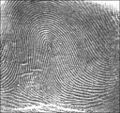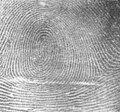Did you know that before fingerprints were used for solving crimes people used them as personal identifiers, kind of like signatures? Fingerprints have been found in the tombs of Egypt to Chinese pottery. In 1684, Nehemiah Grew published the first scientific document describing fingerprints, and in 1788 Johann Mayer recognized that fingerprints are unique in each individual. In 1880 a doctor proposed the usefulness of finger prints for identification and recording them by using a ink method. It was said the chance of a "false positive" or two individuals having the same fingerprint was 1 in 64 billion. It wasn't until 1892 when Francisca Rojas was being accused of killing her two sons that fingerprints were used to convict an individual when a bloody thumb print was found that was identical to Rojas's. The fingerprinting method was soon adopted by many large city police departments, and would become one of the most basic protocols for the booking process.
Types of Fingerprints:
Exemplar: Prints deliberately collected from an indicidual
Latent: Any prints collected from any accidental impression left by friction ridge skin on a surface, and may or may not be visible to the human eye.
Patent: Patent prints are visible to the naked eye and occur when a finger leaves print on surface because it has some kind of foreign material on it.
Plastic: A print that is left on a material that retains the actual shape and detail of the fingertip itself.
Methods for Collecting Fingerprints:
Although there are thousands of methods for collecting fingerprints, there are only about 20 methods that are used most frequently. Chemicals such as Ninhydrin, which reacts with ammonia or primary and secondary amines, can be used on multiple types of surfaces to collect prints. Traditional powder methods are good for typicaly smooth surfaces. To get prints from a porous material evaporation methods can be used to get reactive chemicals in pores or cracks.
Basic Shapes and Patterns:
Arch
Loop
Whorl
Tented Arch
Procedures for Lifting Prints: (Mineral Powder Method)
-Find area you're interested in lifting prints from
-Carefully and delicately dust the selected area, making the powder stick the oils left behind from the print
-Once the print is plainly visible, lift the print by getting some type of clear sticky film (tape can be a substitute) and placing it over the print
-Quickly tear print away from surface.
-Document print and record print type




I found this very interesting; it was very concise!
ReplyDeleteHey, I am doing a forensics project for my college class and I just wanted to let you know that your blog helped me SO much! Great job!
ReplyDeleteThe information is right on! Maybe add a few more pictures for other sections of this post besides the fingerprint types
ReplyDelete